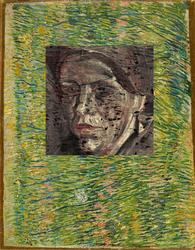Behind the van Gogh painting of a grassy landscape "Patch of grass" (landscape format) there is a portrait of a woman, which has been reconstructed. The measurements were performed at DORIS III at DESY.
Scientists from the TU Delft (Netherlands), University of Antwerp (Belgium), the Kröller-Müller Museum (Netherlands), ESRF (France) and HASYLAB/DESY successfully applied a special technique for the first time to a painting by Vincent van Gogh. This technique allows to uncover pictures which were later painted over to be revealed once more. Behind the van Gogh painting of a grassy landscape there is a portrait of a woman.
It is well-known that the dutch artist often painted over his older works, it is estimate that about thirty percent of his paintings conceal other compositions under them. The techniques usually used to find 'hidden' paintings, such as conventional X-ray radiography, have their limitations. Synchrotron Radiation X-ray fluorescence (SR XRF) spectroscopy has the major advantage that it is element-specific, highly penetrative and can be used with a small beam size. The fluorescence of the layers of paint are measured after excitation with synchrotron radiation. Individual paint pigments, like e.g. 'white lead' (PbCO3) or 'vermillion' (HgS), can therefore be charted individually.
This method was applied to a painting by Vincent van Gogh 'Graslandschap' ('Patch of grass'), which was painted in Paris in 1887 and is owned by the Kröller-Müller Museum (Otterlo, Netherlands). Previous research had already discovered the vague outline of a head behind the painting. The painting was scanned at beamline L at DORIS III. Over the course of two days, the area covering the image of a woman’s head was scanned, measuring 17.5 x 17.5 cm in total. The measurements enabled researchers to reconstruct the concealed painting in unparalleled detail. By combining the distribution of the elements mercury and antimony from specific paint pigments, Joris Dik from TU Delft and his colleagues were able to provide a ‘colour photo’ of the portrait which had been painted over.
The reconstruction enables art historians to understand the evolution of Van Gogh’s work better. The applied technique is expected to pave the way for research into many other concealed paintings.
The results appeared in ASAP Anal. Chem., ASAP Article, 10.1021/ac800965g.
(from: July 29, 2008)
| Further Links |
|






